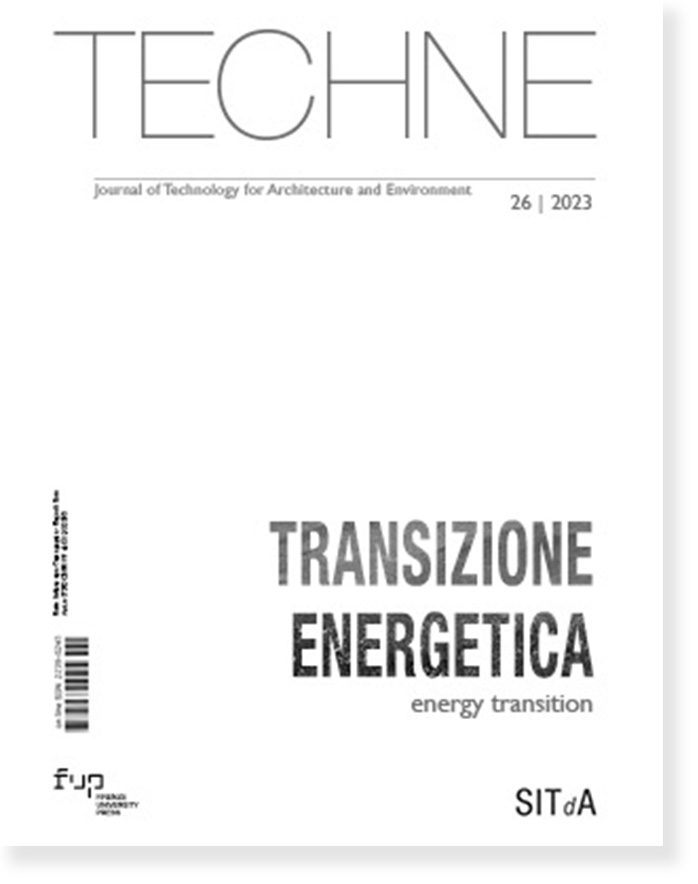Published 2023-10-31
Keywords
- Housing,
- Environmental Awareness,
- Energy Efficiency,
- Energy Citizenship,
- Artificial Intelligence (AI)
How to Cite
Copyright (c) 2023 Chiara Tonelli, Giuliana Nardi, Barbara Cardone

This work is licensed under a Creative Commons Attribution 4.0 International License.
Abstract
Ecological transition requires a significant change in the construction industry, which is responsible for 40% of final energy consumption. In Italy, residential buildings account for more than 27% of energy consumption, 12 out of 14 million. Their renovation is, therefore, an important objective to achieve a sustainable built environment. However, a drastic reduction in energy demand is also needed in residential buildings, as widespread ownership does not allow comprehensive control of domestic consumption. Hence the importance that dwellers understand the direct link between their actions and climate change so that efficiency efforts are not in vain. The paper identifies in artificial intelligence an educational tool on energy citizenship.
Downloads
References
Eurostat (2021), Energy Balances, Available at https://ec.europa.eu/eurostat/web/energy/data/energy-balances. (Accessed on 28/02/2023).
European Commission (2020), Comunicazione della Commissione al Parlamento Europeo, al Consiglio, al Comitato Economico e Sociale Europeo e al Comitato delle Regioni. Un’ondata di ristrutturazioni per l’Europa: inverdire gli edifici, creare posti di lavoro e migliorare la vita, COM(2020) 662 final Available at: https://eur-lex.europa.eu/legal-content/IT/TXT/HTML/?uri=CELEX:52020DC0662&from=IT. (Accessed on 28/02/2023).
Camera dei Deputati (2023), La revisione della direttiva sulla prestazione energetica degli edifici, Dossier n° 17. Available at: https://documenti.camera.it/Leg19/Dossier/Pdf/AT017.Pdf. (Accessed on 28/02/2023).
European Commission (2021), Direttiva del Parlamento Europeo e del Consiglio sulla prestazione energetica nell’edilizia (rifusione), COM(2021) 802 final, 2021/0426(COD). Available at: https://eur-lex.europa.eu/legal-content/IT/TXT/HTML/?uri=CELEX:52021PC0802&qid=1645624555853&from=IT. (Accessed on 28/02/2023).
European Commission (2019), Communication from the commission to the European parliament, the European council, the council, the European economic and social committee and the committee of the regions - the European green deal, Brussels, 11.12.2019 COM (2019) 640 final. Available at: https://eur-lex.europa.eu/resource.html?uri=cellar:b828d165-1c22-11ea-8c1f-01aa75ed71a1.0006.02/DOC_1&format=PDF. (Accessed on 28/02/2023).
Istat (2011), Censimento Popolazione e Abitazioni. Edifici residenziali
Manfren M., Aste N., Leonforte F., Del Pero C., Buzzetti M., Adhikari R. S. and Zhixing L. (2020), “Parametric energy performance analysis and monitoring of buildings—HEART project platform case study”, Sustainable Cities and Society, vol. 61, p. 1-16, ISSN: 2210-6707. Available at: https://doi.org/10.1016/j.scs.2020.102296. (Accessed on 28/02/2023).
Butera F. M., Caputo P., Adhikari R. S. and Mele R. (2019), “Energy access in informal settlements. Results of a wide on site survey in Rio De Janeiro”, Energy Policy, vol. 134, p. 1-10, ISSN: 0301-4215. Available at: https://doi.org/10.1016/j.enpol.2019.110943. (Accessed on 28/02/2023)
Aste, N., Del Pero, C., Adhikari, R. S. and Marenzi, G. (2015), “Effectiveness and weaknesses of supporting policies for solar thermal systems - A case-study”, Sustainable Cities and Society, vol. 14, p. 146-153, ISSN: 2210-6707. Available at: https://doi.org/10.1016/i.scs.2014.09.003. (Accessed on 28/02/2023)
Istat (2021), Titolo di godimento dell'abitazione (in affitto o di proprietà): Regioni e tipo di comune. Available at: http://dati.istat.it/
PNRR (2021), Piano Nazionale di Ripresa e Resilienza, Roma, Palazzo Chigi, 25.
Tonelli, C. (2022), La casa 4.0. Nuove frontiere dell'abitare. (Ri)progettare la propria casa, Maggioli Editore
Aydin, E., Kok, N., Brounen, D., (2017), “Energy efficiency and household behavior: the rebound effect in the residential sector”, RAND Journal of Economics, 48 (3). Available at: https://doi.org/10.1111/1756-2171.12190 (Accessed on 28/02/2023)
Aydin, E., Brounen, D., Kok, N. (2018), “Information provision and energy consumption: evidence from a field experiment”, Energy Economics, 71. Available at: https://doi.org/10.1016/j.eneco.2018.03.008 (Accessed on 28/02/2023)
Galassi, V., Madlener, R. (2018), “Shall I open the window? Policy implications of thermal-comfort adjustment practices in residential buildings”, Energy Policy, 119. Available at: https://doi.org/10.1016/j.enpol.2018.03.015. (Accessed on 28/02/2023
Sorrell, S., Gatersleben, B., Druckman, A., (2018), “Energy sufficiency and rebound effects”, European Council for an Energy Efficient Economy, Available at: https://www
energysufficiency.org/libraryresources/library/items/energy-sufficiency-and-rebound-effects-concept-paper (Accessed on 28/02/2023)
Druckman, A., Chitnis, M., Sorrell, S., Jackson, T., (2011) “Missing carbon reductions? Exploring rebound and backfire effects in UK households”, Energy Policy, 39 (6) Available at: https://doi.org/10.1016/j.enpol.2011.03.058
Psomas, T., Heiselberg, P., Duer, K., Bjørn, E., (2016) “Overheating risk barriers to energy renovations of single family houses: multicriteria analysis and assessment”, Energy Buildings, 117,
Available at: https://doi.org/10.1016/j.enbuild.2016.02.031 (Accessed on 28/02/2023)
Stephenson, J., Barton, B., Carrington, G., Gnoth, D., Lawson, R. and Thorsnes, P. (2010), “Energy cultures: A framework for understanding energy behaviours”, Energy Policy, 38(10), 6120–6129. Available at: https://doi.org/10.1016/j.enpol.2010.05.069. (Accessed on 28/02/2023)
Stephenson, J., Barton, B., Carrington, G., Doering, A., Ford, R., Hopkins, D. and Wooliscroft, B. (2015), “The energy cultures framework: Exploring the role of norms, practices and material culture in shaping energy behaviour in New Zealand”, Energy Research & Social Science, 7, 117–123. Available at: https://doi.org/10.1016/j.erss.2015.03.005. (Accessed on 28/02/2023)
Rau, H., Moran, P., Manton, R. and Goggins, J. (2020), “Changing energy cultures? Household energy use before and after a building energy efficiency retrofit”, Sustainable Cities and Society, 54, 101983. Available at: https://doi.org/10.1016/j.scs.2019.101983. (Accessed on 28/02/2023)
Gill, Z. M., Tierney, M. J., Pegg, I. M. and Allan, N. (2010), “Low-energy dwellings: The contribution of behaviours to actual performance”, Building Research & Information, 38(5), 491–508. Available at: https://doi.org/10.1080/09613218.2010.505371. (Accessed on 28/02/2023)
Gram-Hanssen, K. (2010), “Residential heat comfort practices: Understanding users”, Building Research & Information, 38(2), 175–186. Available at: https://doi.org/10.1080/09613210903541527. (Accessed on 28/02/2023)
Zubi, G., Spertino, F., Carvalho, M., Adhikari, R. S., Khatib, T. (2017), “Development and assessment of a solar home system to cover cooking and lighting needs in developing regions as a better alternative for existing practices”, Solar Energy, vol. 155, p. 7-17, ISSN: 0038-092X. Available at: https://doi.org/10.1016/j.solener.2017.05.077. (Accessed on 28/02/2023)
Ragnedda, M. (2017). The third digital divide: A Weberian approach to digital inequalities. Routledge
Lythreatis, S., Singh, S., K., El-Kassar, A., (2022), “The digital divide: A review and future research agenda”, Technological Forecasting and Social Change, Volume 175. Available at:
https://doi.org/10.1016/j.techfore.2021.121359. (Accessed on 28/02/2023)
Mertens, S., Herberz, M., Hahnel, U. J., & Brosch, T. (2022), “The effectiveness of nudging: A meta-analysis of choice architecture interventions across behavioral domains”, Proceedings of the National Academy of Sciences, 119(1), e2107346118. Available at: https://www.pnas.org/doi/epdf/10.1073/pnas.2107346118. (Accessed on 28/02/2023)






